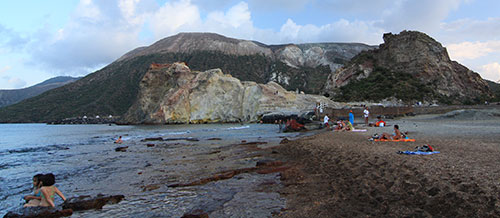
|
The name of the island of Vulcano comes from the Roman god, formerly called ‘Hierà’. It is composed of four volcanoes:
– “Vulcanello”, 120 meters high, is the result of an eruption in the 2nd century BC and is connected to the northern end of the island through a narrow strip of land made of lava debris. – “Great Crater” or “Big Pit”, 380 meters high, has a limited activity with the fumaroles; the last eruption, which completely destroyed the entire village, dates back to 1888/1890 but volcanologists still consider it as a threat. – Between the two craters there are the amazing bays of “Porto Levante”- made of coasts with jagged and colorful cliffs, with the black and fine sand protected by the “stack of the Mermaids” – and “Porto Ponente” which is popular for its very hot water due to submarine sulfur sources, caused by the leakage of hot gas from the sea bed. – “Monte Saraceno”, higher than 481 meters a.s.l. – Finally, to the south, the “Monte Aria” (about 499 meters a.s.l.) is the highest peak of Vulcano. The last two craters are inactive today. The area of “Piano” is a cleft between the “Great Crater” and “Monte Aria” and is a very green upland, cultivated with orchards and vineyards. The volcano has been active since ancient times. According to mythology the crater of the volcano is the location of the laboratory of Hephaestus and his cyclops. /div> |


